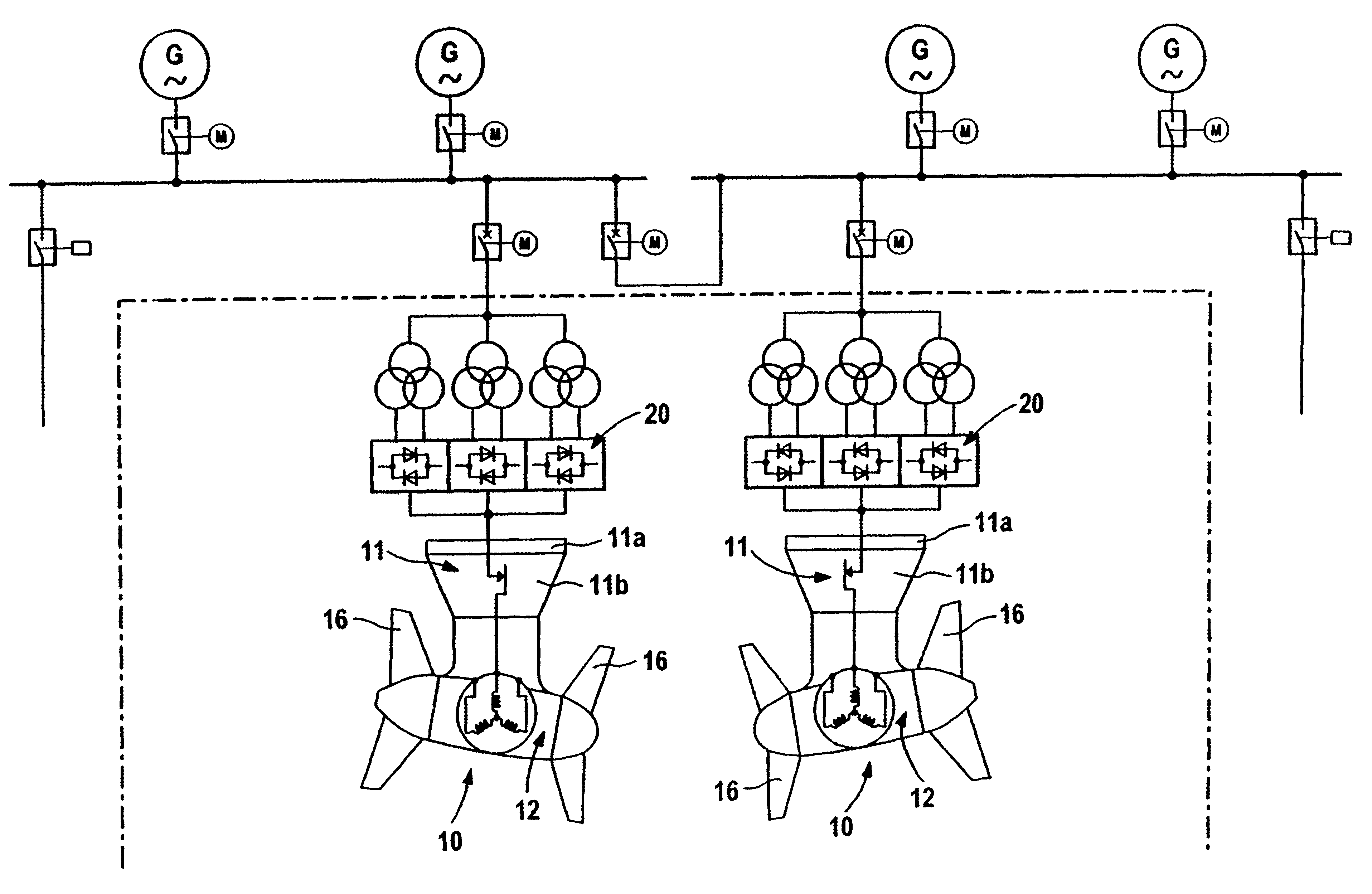One
disadvantage in this case is the considerable logistic complexity and hence considerable cost, which is further increased by the fact that both the manufacture of the individual components and the wiring and testing of the complete system necessitates inspection by a Classification Organization for example the American Bureau of Shipping (ABS), Bureau Veritas (BV), Der Norske Veritas (DNV), Germanischer Lloyd (GL) or Lloyds Register of Shipping (LRS).
This is primarily due to the presence of at least two identical steering propellers with an
autonomous control and regulation device, which results in homogeneous redundancy in the propulsion system.
Ship propulsion systems, in particular steering propeller propulsion systems, produce oscillations during operation which propagate through the entire ship's
hull and cause vibration in it.
However, this is not the case since, in particular, even a ship's propeller represents an oscillating load for the propulsion system, to be precise because the propeller blades partly move along the skeg or propeller-shaft stay (which is fitted to the ship's
hull) during their rotational movement but, in contrast, can move largely free from this stay during another part of their rotational movement.
This method is on the one hand expensive while, on the other hand, it reduces the maximum permissible cargo weight in the ship, increases the fuel consumption and, furthermore, although it may reduce the material-destructive effects of the oscillations produced by the propulsion system, cannot, however, eliminate the cause.
Particularly in the region of a skeg or propeller-shaft stay fitted to the ship's hull, the
operating point of the propeller can reach or exceed the
cavitation limit, thus initiating cavitation which can then cause considerable damage to the ship and, in particular, to the propeller.
Cavitation also leads to unacceptable pressure fluctuations and
noise which, in particular, considerably reduces the operational value of passenger, research and military ships.
One
side effect in this case is that the rotation speed of the propeller does not remain exactly constant, but is subject to certain fluctuations, caused by the changing load.
However, this is of very minor importance for the forward propulsion produced by the propeller.
A further exasperating factor is that the values quoted there are often no longer satisfied these days, owing to lack of adequate maintenance, particularly in the upper power region.
This time gradient must not be exceeded, even in places, since otherwise, the
diesel engine may be damaged.
If the propulsion system for ship's propellers exceed the dynamic limits of the diesel engines in the
diesel generator system, the frequency of the on-board power
supply network supplied by the
diesel generator system fluctuates to unacceptable extents.
It is also possible for the diesel engines to be damaged, since the rotation speed control for the
diesel generator system must keep the frequency of the on-board power
supply network within a permissible range irrespective of the dynamic limits.
If the dynamic limits of the synchronous generators in the diesel generator system are exceeded, the
voltage of the on-board power
supply network fluctuates unacceptably.
In this case, it was often only possible to optimize specific operating points.
Otherwise, considerable beat frequencies would occur in the electric propeller motor, and these would appear as mechanical oscillations or structure-borne
sound sources in the ship, in particular, there would be a risk of the ship's propeller starting to cavitate, which in turn could lead to damage to the ship's propeller and to the ship.
This thus leads to
voltage fluctuations in the on-board power supply network, since the excitation for the synchronous generators in the diesel generator system can no longer follow the rate of change of the current nominal value.
This has the unpleasant effect for
ship control that the drive and propulsion system drops into a hole when accelerating over certain rotation speed ranges, and effectively stops.
Furthermore, the
power demand pumped by the drive and propulsion system from the ship's on-board power supply network is therefore also undesirable, since it necessitates an unnecessary
power margin in the on-board power supply network.
The ramp transmitters used in the past for drive devices for ship's propellers which were controlled in steps are unable to assign a defined acceleration torque to the electric propeller motor during acceleration processes and, in fact, they simply produce only the respective current limits appropriate at that time over wide rotation speed ranges of the electric propeller motor.
 Login to View More
Login to View More  Login to View More
Login to View More 









